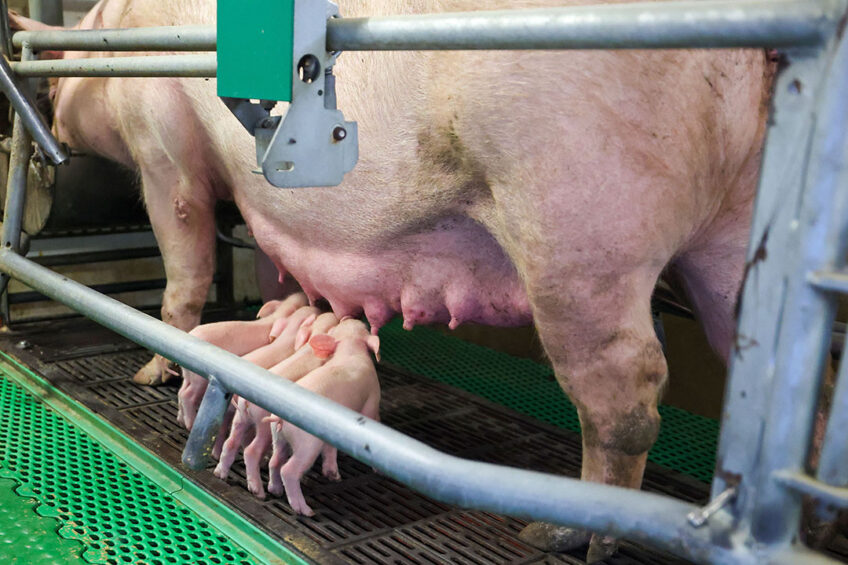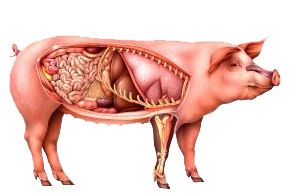5 lactating sow diet requirements

In sow herds, the transition from pregnancy to lactation is associated with physiological alterations and therefore changes in feeding. To avoid reproductive and health problems it is essential to be aware of the feeding requirements of lactating sows.
During gestation, sows are restrictively fed to prevent excessive weight gain but during lactation sows are allowed to consume feed ad libitum to cover required nutrients to maintain body tissues and support milk production.
However, voluntary feed intake of highly prolific sows is generally insufficient which results in body weight loss. Excessive body weight loss leads to short-term reproductive problems such as extended weaning-to-oestrus interval and smaller subsequent litter size and long-term problems such as higher culling rate, low average parity, reduced pigs weaned per reproductive lifetime, and higher costs per pig produced. Therefore, it is essential to understand feeding requirements of lactating sows to develop a successful feeding programme.
 Energy requirements
Energy requirements
During the lactation period, energy requirements vary based on sow weight, milk yield and composition, and the housing conditions. Usually, sows do not consume enough feed during lactation to meet their energy needs for maintenance and milk production. As a result, sows mobilise their own body tissues which leads to excessive weight loss thus compromising subsequent reproductive performance. Increasing the energy density in the lactation diet enhances energy intake during lactation thus minimising catabolism of maternal body reserves.
A dietary digestible energy density of 14.05 MJ/kg dietary energy is recommended for lactating sows of parity 2 and above with a litter size of 11.5 and a litter average daily gain of 190-270 g/day. In addition, fat can be supplemented to lactation diets to increase energy intake of sows.
 Water requirements
Water requirements
Water accounts for 80% of body weight at birth and declines to about 50% in sows. Water requirements vary based on body weight and water to feed ratios, with normal ratios of 2:1 to 3:1. Lactating sows have the greatest water requirement attributed to meeting the demands of milk production and to encourage feed consumption.
Water requirements for lactating sows range from 5 to 10 gallons per day. It is essential to provide an adequate supply of water with sufficient flow rate of 1.5-2 pints per minute for lactating sows. Restricted access to water decreases feed intake and sow and litter performance during lactation.
 Protein requirements
Protein requirements
Protein requirements are expressed in terms of amino acid recommendations. Dietary protein affects the amount of feed consumed by the sow during lactation. Decreasing dietary crude protein level leads to reduced feed consumption, and consequently increased weight loss in sows over the lactation period. Lysine is the first limiting amino acid in grain-soybean meal-based diets. The lactation diet composition should provide a minimum concentration of 17.5% crude protein, and 0.9 to 1.0% total lysine. Most parity 1 and some underconditioned parity 2 sows need about 1.2% lysine in the diet. Amino acid requirements are determined separately for maintenance and milk production using separate amino acid ratios relative to lysine for each and then are adjusted based on the amount of amino acid expected to be obtained from protein stores due to sow body weight loss. In addition, to achieve the recommended levels a 5% safety margin over the actual estimated level of amino acid requirement is considered.
 Mineral and vitamin requirements
Mineral and vitamin requirements
Highly prolific and multiparous sows require greater levels of vitamins and minerals. Copper, zinc, iron, iodine, manganese, chromium, and selenium are typically supplemented to lactation diets. In addition, the lactation diet should contain a minimum concentration of 0.9 % calcium, 0.8 % total phosphorus, and 0.5 % available phosphorus. Furthermore, vitamins A, D3, E, K, riboflavin, niacin, pantothenic acid, choline, biotin, B12, B6 and folic acid are needed in lactating sow diet.
 Fibre requirements
Fibre requirements
Supplementing fibre-rich feed ingredients to the sow diet before and a few days after farrowing prevents constipation, reduces incidence of mastitis, inhibits twisted gut, and improves sow comfort. However, feed ingredients with high fibre content including soy hulls, oats, wheat midds, beet pulp, alfalfa hay and wheat bran may limit total nutrient intake. Crude fibre concentration should be limited to around 3-4% in the lactating sow diet.
 PIG PROGRESS HEALTH TOOL
PIG PROGRESS HEALTH TOOL
The tool focuses on causes, clinical signs and proven treatment and available control measures. Check it out…
Concluding thoughts
Lactating sow diet is essential to avoid short-term and long-term reproductive problems and to maintain herd profitability. Energy, water, protein, minerals, vitamins, and fibre are important diet ingredients for lactating sows. Swine producers need to ensure the proper formulation of lactating diet and maximum lactation feed intake by sow to improve herd health, welfare, and productivity.
* References will be provided upon request.











